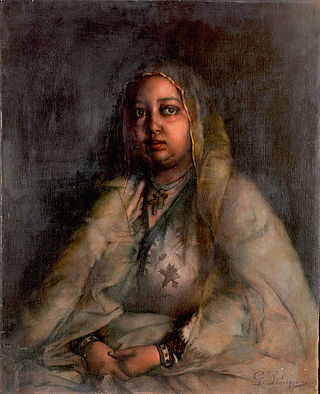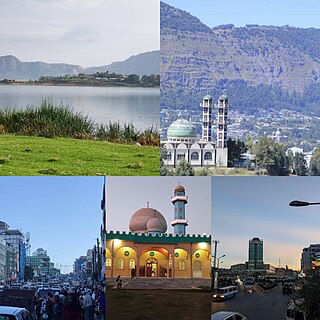
The Battle of Adwa was the climactic battle of the First Italo-Ethiopian War. Ethiopia managed to defeat the invading Italian force led by Oreste Baratieri on Sunday, March 1, 1896, near the town of Adwa. The decisive victory thwarted the campaign of the Kingdom of Italy to expand its colonial empire in the Horn of Africa. By the end of the 19th century, European powers had carved up almost all of Africa after the Berlin Conference; only Ethiopia and Liberia still maintained their independence. Adwa became a pre-eminent symbol of pan-Africanism and secured Ethiopian sovereignty until the Second Italo-Ethiopian War forty years later.

The First Italo-Ethiopian War, also referred to as the First Italo-Abyssinian War, or simply in Italy as the Abyssinian War, was a war fought between Italy and Ethiopia from 1895 to 1896. It originated from the disputed Treaty of Wuchale, which the Italians claimed turned Ethiopia into an Italian protectorate. Full-scale war broke out in 1895, with Italian troops from Italian Eritrea achieving initial successes against Tigrayan warlords at Coatit, Senafe and Debra Ailà, until they were reinforced by a large Ethiopian army led by Emperor Menelik II. The Italian defeat came about after the Battle of Adwa, where the Ethiopian army dealt the heavily outnumbered Italian soldiers and Eritrean askaris a decisive blow and forced their retreat back into Eritrea. The war concluded with the Treaty of Addis Ababa. Because this was one of the first decisive victories by African forces over a European colonial power, this war became a preeminent symbol of pan-Africanism and secured Ethiopia's sovereignty until the Second Italo-Ethiopian War of 1935–37.

Menelik II, baptised as Sahle Maryam was king of Shewa from 1866 to 1889 and Emperor of Ethiopia from 1889 to his death in 1913. At the height of his internal power and external prestige, the process of territorial expansion and creation of the modern empire-state was largely completed by 1898.

Taytu Betul was Empress of Ethiopia from 1889 to 1913 and the third wife of Emperor Menelik II. An influential figure in the anti-colonial resistance during the late 19th-century Scramble for Africa, she, along with her husband, founded the modern Ethiopian capital Addis Ababa in 1886.

RasMakonnen Wolde Mikael Wolde Melekot, or simply Ras Makonnen, also known as Abba Qagnew, was an Ethiopian royal from Shewa, a military leader, the governor of Harar, and the father of future Emperor Haile Selassie. Described by Nikolai Gumilev as “one of the greatest leaders of Abyssinia”, he served in the First Italo-Ethiopian War, playing a key role at the Battle of Adwa.

Adwa is a town and separate woreda in Tigray Region, Ethiopia. It is best known as the community closest to the site of the 1896 Battle of Adwa, in which Ethiopian soldiers defeated Italian troops, thus being one of the few African nations to thwart European colonialism. Located in the Central Zone of the Tigray Region, Adwa has a longitude and latitude of 14°10′N38°54′E, and an elevation of 1907 meters. Adwa is surrounded by Adwa woreda.

Dessie is a town in north-central Ethiopia. Located in the South Wollo Zone of the Amhara Region, it sits at a latitude and longitude of 11°8′N39°38′E, with an elevation between 2,470 and 2,550 metres above sea level. Dessie is 400 km to the north of the capital Addis Ababa. It has a population of more than 200,000 people in over 30 wards.
The Treaty of Wuchale was a treaty signed between the Ethiopian Empire and the Kingdom of Italy. The signing parties were King Menelik II of Shewa, acting as Emperor of Ethiopia, and Count Pietro Antonelli representing Italy, on 2 May 1889, established the treaty after the Italian occupation of Eritrea. It was signed in the small Ethiopian town of Wuchale, from which the treaty got its name. The purpose of the treaty was to promote friendship and trade among the two countries. It was a treaty to maintain a positive long-lasting relationship between the two empires. The treaty has twenty articles written in two languages, Amharic and Italian; however, there were marked differences in the Italian and the Amharic versions of the treaty, which created miscommunications between the two countries. Specifically, Article 17 of the treaty was translated and interpreted differently by Ethiopia and Italy. Italy claimed the article imposed a protectorate over Ethiopia, while Ethiopia claimed the article allowed international diplomacy to be conducted through Italy by choice. When Menelik II denounced the treaty in 1893, Italy attempted to forcefully impose the protectorate over Ethiopia in the First Italo-Ethiopian War, which ended with Italy's defeat at the Battle of Adwa and the resulting Treaty of Addis Ababa.

Afäwarq Gäbrä Iyäsus was an Ethiopian writer, who wrote the first novel in Amharic, Ləbb Wälläd Tarik, . Bahru Zewde writes, "Few people before or after him have demonstrated such superb mastery of the Amharic language. Few have ventured with such ingenuity into the hidden recesses of that language to come out with a wealth of vocabulary and idiom one scarcely thought the language possessed. Afäwarq is nonetheless a controversial figure for having supported the Italians during both the First and Second Italo-Ethiopian Wars.
The Treaty of Addis Ababa, signed 23 October 1896, formally ended the First Italo-Ethiopian War on terms mostly favorable to Ethiopia. This treaty superseded a secret agreement between Ethiopia and Italy negotiated days after the decisive Battle of Adwa in March of the same year, in which Ethiopian forces commanded by Menelik II defeated the Italians. The most important concession the Italians made was the abrogation of the Treaty of Wuchale and recognizing Ethiopia as an independent country.
Berehet is one of the woredas in the Amhara Region of Ethiopia. Part of the Semien Shewa Zone, Berehet is bordered on the south by the Germama River which separates it from Menjarna Shenkora, on the west by Hagere Mariamna Kesem, on the north by Asagirt, and on the east by the Afar Region. The major town in Berehet is Metiteh Bila.

Sekota, also spelled Sokota, Sakota, Soqota is a town and separate woreda in northern Ethiopia. The name is likely from the Agaw word sekut, "fortified village." Located in the Wag Hemra Zone of the Amhara Region, Sekota has a latitude and longitude of 12°37′31″N39°02′06″E and an elevation of 2266 meters above sea level. It is surrounded by woreda of Soqota.
Were Ilu is a town in north-central Ethiopia. Located in the Debub Wollo Zone of the Amhara Region, this town has a latitude and longitude of 10°36′N39°26′E. From the 1870s, Were Ilu had a Thursday market.

Ras Alula Engida was an Ethiopian general and politician who successfully led battles against Ottoman Egypt, the Mahdists and Italy. He was one of the most important leaders of the Abyssinian forces during the 19th century. Described by Haggai Erlich as the "greatest leader whom Ethiopia produced since the death of Emperor Tewodros II in 1868." Ras Alula was referred to by Europeans as "the Garibaldi of Ethiopia".
Events from the year 1890 in Italy.
Yisma Nigus is an Ethiopian historical site where the Treaty of Wuchale was signed by Menelik II and Count Pietro Antonelli of Italy on 2 May 1889. Disputes over the treaty would later lead to the First Italo-Ethiopian War.

The Italo-Ethiopian War of 1887–1889 was an undeclared war between the Kingdom of Italy and the Ethiopian Empire occurring during the Italian colonization of Eritrea. The conflict ended with a treaty of friendship, which delimited the border between Ethiopia and Italian Eritrea but contained clauses whose different interpretations led to another Italo-Ethiopian war.

Ethiopia–United Kingdom relations are the bilateral relations between Ethiopia and the United Kingdom. Currently, Ethiopia has an embassy in London and United Kingdom has an embassy in Addis Ababa. Historically, their relations traced over centuries covered a range of areas including, but not limited to, trade, culture, education and development cooperation. The UK is the first country to open its embassy in Addis Ababa. Ethiopia is the first African country to open an embassy in London.

The Eritrea–Ethiopia border encompasses a roughly 1,033 km boundary between the two states. The borders are the Afar and Tigray regions of Ethiopia.
Welle Betul also known as Wale Betul, Wolie Betul and Wele Bitul, was an Ethiopian military commander under Emperor Menelik II, the ruler of Begemder, and the younger brother of Empress Taytu Betul.













